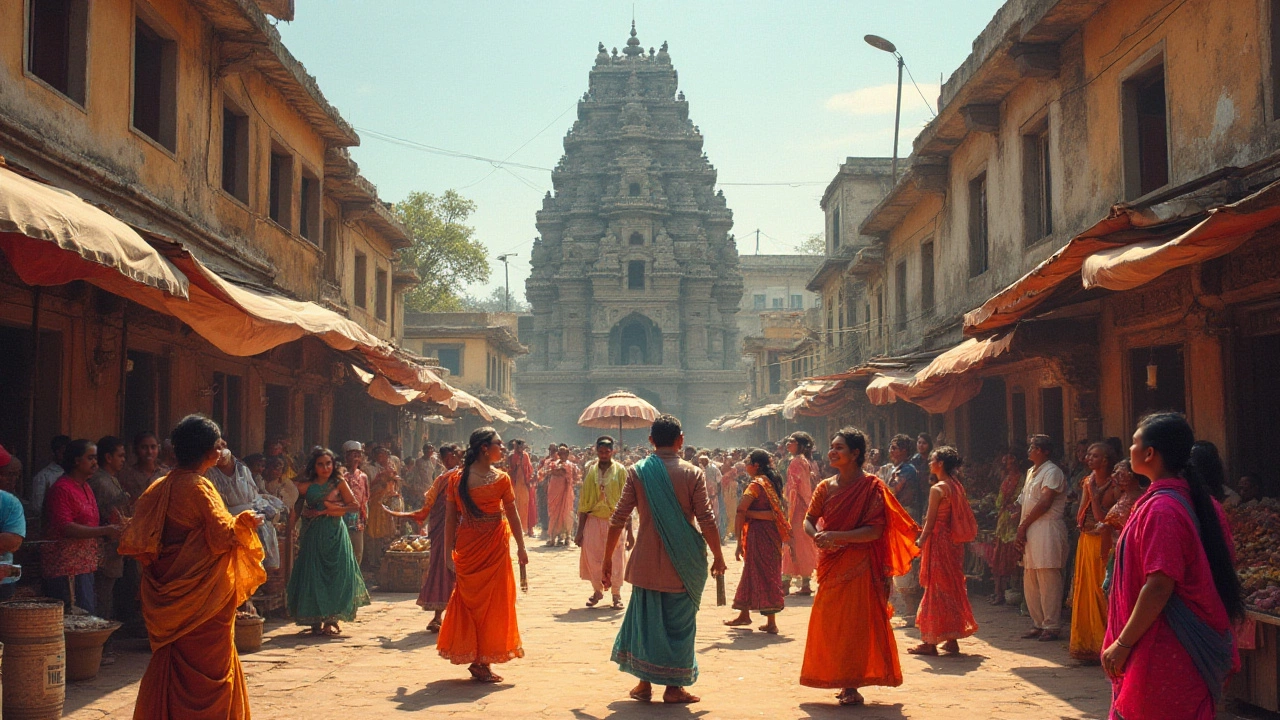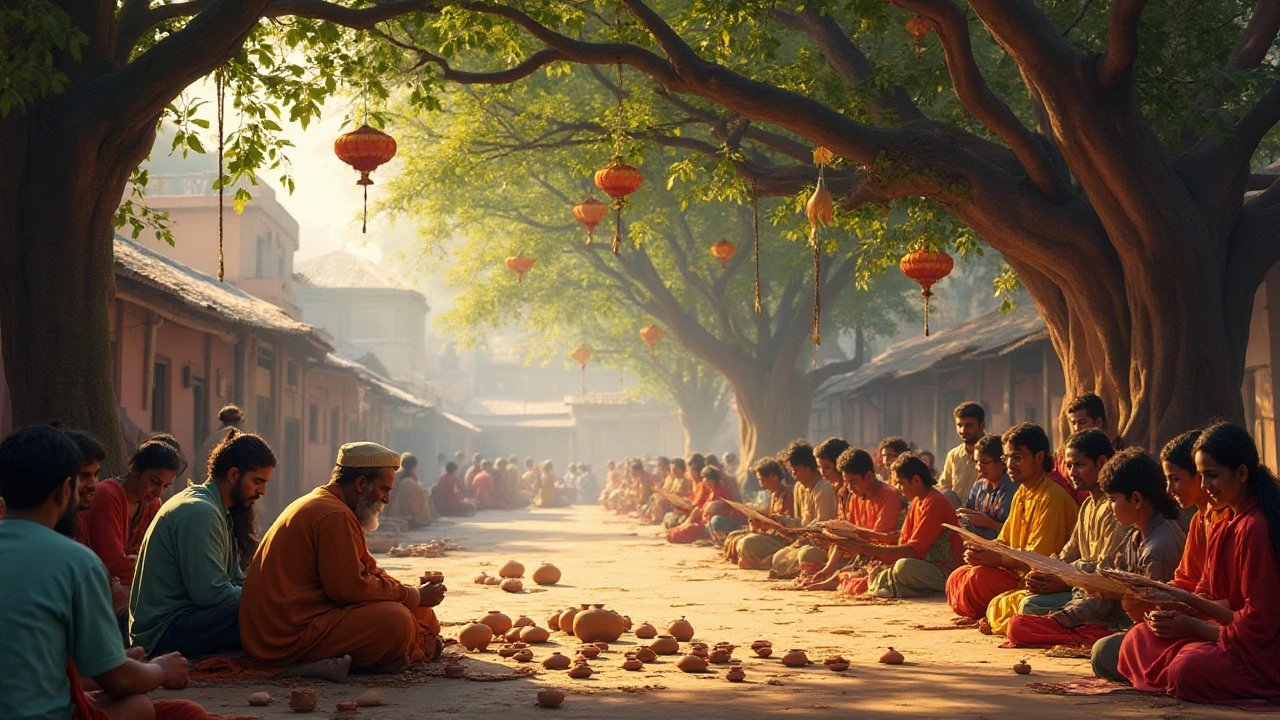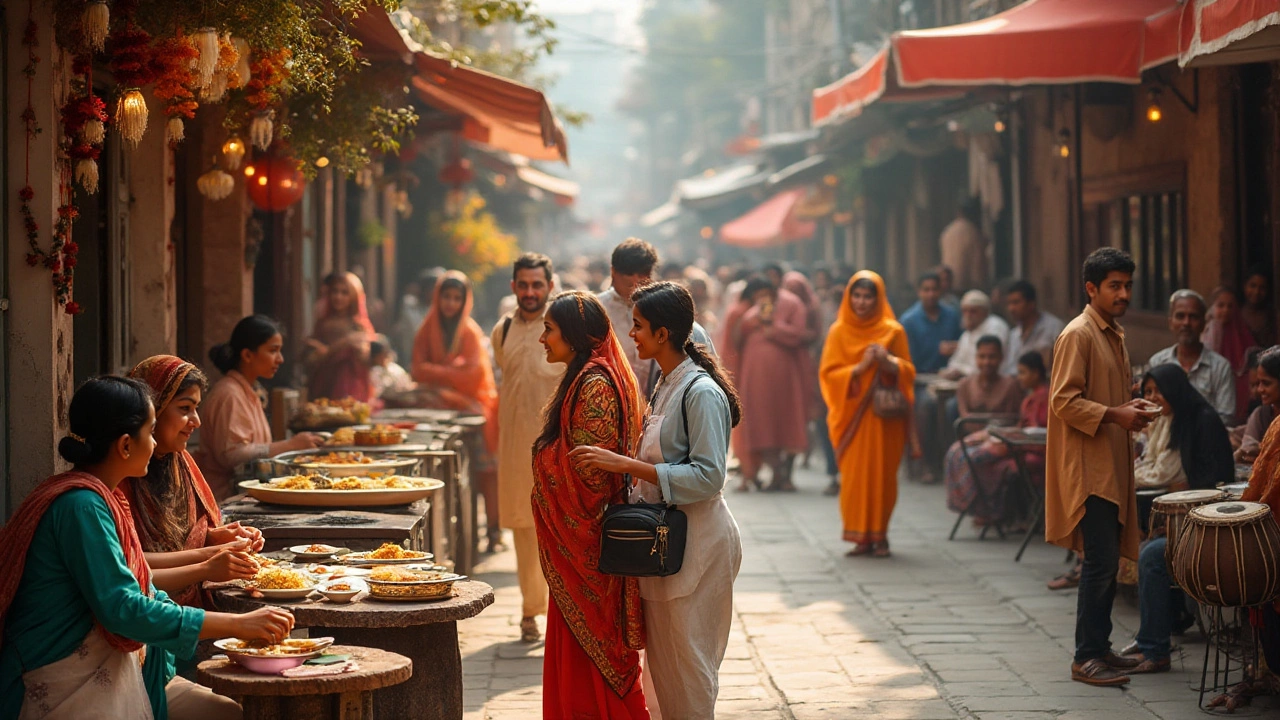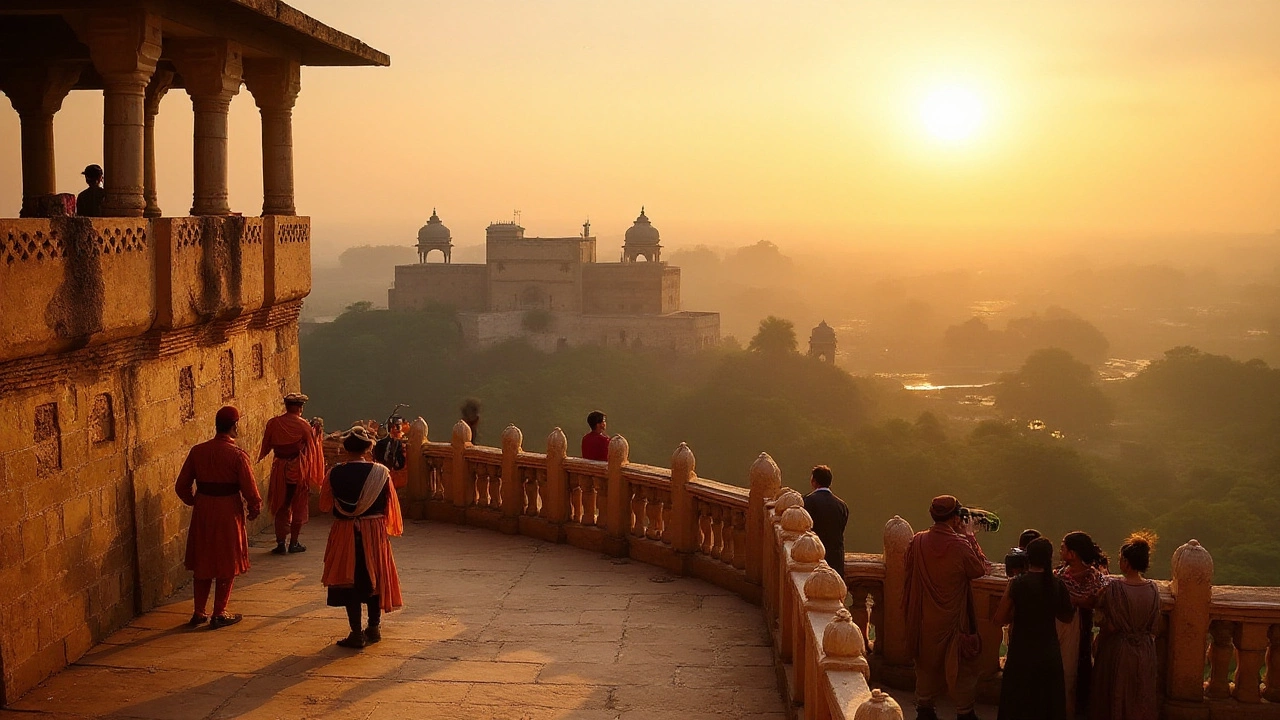Exploring the Two Facets of Cultural Tourism in India
 Jan, 4 2025
Jan, 4 2025
India, with its kaleidoscope of colors, traditions, and rituals, offers an unforgettable journey into the heart of cultural tourism. This vibrant land embraces diversity through a myriad of languages, customs, and stories told through dance, music, and art. For those looking to explore this cultural wealth, two main types of tourists emerge, each with a distinct approach to experiencing India's cultural landscape.
The experiential tourists seek to dive deep into the cultural fabric, often rolling up their sleeves to get hands-on with local activities. These travelers engage in cooking classes, traditional art workshops, and even local festivals to truly understand the essence of the culture. On the other side, observational tourists prefer a more laid-back approach, soaking in the culture from a distance, whether by attending performances or exploring museums.
Whichever path you choose, India stands ready to captivate and enrich. As we delve into the two types of cultural tourists, we'll uncover tips and insights to make any cultural journey across India not only memorable but deeply transformative.
- Understanding Experiential Tourists
- Exploring the Observational Tourists
- Cultural Attractions in India
- Tips for a Memorable Cultural Journey
Understanding Experiential Tourists
The vibrant world of cultural tourism in India beckons a unique breed of travelers known as experiential tourists. These individuals are not content with just standing on the sidelines; they crave an immersive experience that allows them to live and breathe the culture they are exploring. Without a doubt, experiential tourists bring an unparalleled level of curiosity and enthusiasm to their travels, eager to swap the familiar comfort of their daily lives for the exuberance of new cultural encounters. Engaging directly with local communities, they take part in traditional ceremonies, learn the nuances of local handicrafts, and sometimes even stay with local families to experience everyday life firsthand. This approach not only educates them but also fosters cross-cultural connections.
Their journeys are fueled by a desire to learn and experience the world for all its diversity and richness, which makes India an ideal destination. Known for its vast cultural experiences, India offers everything from the rhythmic beats of Kathak and Bharatnatyam dance forms to picturesque traditional art forms like Tanjore painting and Madhubani art. Experiential tourists seek to understand the stories and beliefs behind these cultural treasures. They might join a dance workshop, painting class, or cooking session to gain a deeper appreciation of the skills required. Their approach can lead to a profound understanding of the people and traditions that form the cultural backbone of any region.
In India's vibrant cities, towns, and villages, experiential tourists often find themselves in bustling markets or serene spiritual sites. In these spaces, they learn not only from locals but also from fellow travelers. For instance, the Pushkar Camel Fair offers more than just the spectacle of hundreds of decorated camels; it offers cultural tourists the chance to engage with traders, artists, and performers from various regions, each sharing stories that go beyond guidebook readings. Their experiences can be transformative, often inspiring these tourists to advocate for local traditions long after their journey ends.
An interesting fact about experiential tourism in India is its focus on sustainable travel practices. By participating in these experiences, travelers support local artisans and contribute to the preservation of cultural heritage. This adds an ethical dimension to their travels, ensuring that their presence supports, rather than disrupts, local ecosystems and economies. According to a survey by the Indian Ministry of Tourism, nearly 40% of cultural tourists are now taking part in workshops and community-based programs—evidence of a growing trend among travelers seeking more meaningful connections during their journeys.
"The best journeys answer questions that in the beginning you didn't even think to ask," said Jeff Johnson, a well-regarded travel expert, capturing the recurring elements of curiosity and discovery inherent in experiential travel. The spirit of learning, and a willingness to fully engage with unfamiliar surroundings, characterized this group of travelers, making their experiences both enriched and enlightening.
Overall, experiential tourists in India are embarking on a journey that goes far beyond snapping photos or ticking off "must-see" sites from a list. They tread a path of cultural empathy, emerging with stories of personal growth and new perspectives. It's a mode of travel that challenges assumptions and broadens horizons, making it an increasingly popular choice for those looking to deepen their understanding of the world through the lens of culture. For those interested in becoming experiential tourists, embracing the unpredictability and opening themselves up to connection are often the first steps on a journey filled with unexpected discoveries.

Exploring the Observational Tourists
Observational tourists are those who prefer to experience a culture from a slightly removed perspective. In India, this type of cultural tourism allows for a different kind of engagement where visual and auditory senses soak up the richness of the country's heritage. India is particularly well-suited for these journeys of observation, thanks to its plethora of historic sites, vibrant festivals, and thriving urban and rural cultures. Whether standing in awe before the Taj Mahal at sunrise or listening to the harmonious chords of a traditional sitar performance beneath an ancient fort, observational tourists gain immense pleasure and insight through the simple act of taking it all in.
One of the most profound ways observational tourists connect with cultural tourism in India is by visiting its many museums and monuments. These destinations often serve as time capsules of history, waiting to be explored. The Indian Museum in Kolkata, for example, is the oldest museum in India and houses an extensive collection from India's ancient past. On the other hand, New Delhi's National Museum offers exhibitions ranging from prehistoric artifacts to contemporary art. Observational tourists find themselves walking through layers of India’s history without the need for direct interaction, allowing them to absorb stories at their own pace.
India's festivals also offer a fruitful ground for observational tourism. The flurry of colors in events like Holi or Diwali can be overwhelming yet mesmerizing for tourists. Observers can stand back and enjoy the intricate dance performances, music, and rituals that unfold in cities across the country. These celebrations provide an exciting opportunity to understand the role of mythology and tradition in modern Indian society. As Jawaharlal Nehru once said,
"Culture is the widening of the mind and of the spirit."Observational tourists often find this mind and spirit opening simply by being present in these cultural events.
Another excellent opportunity for observational tourists in India lies within its architecture, from grand palaces to humble havens. The intricate designs of Indian temples, like the Meenakshi Amman Temple in Madurai, draw visitors not just for spiritual meditation but also for their architectural grandeur. Walking tours of ancient sites like Hampi or exploring the royal palaces of Jaipur can offer insightful glimpses into the grandeur and complexities of India's past. Observational tourists can document such travels in their photography or travel notes, sharing their visual journeys with the world.
Observational tourism has its unique impact on local economies and communities. These tourists may not engage directly, but their presence supports local artisans and businesses by visiting destinations and participating as spectators. The sustaining gaze of an observer can breathe life into regions where cultural displays rely on tourist interest. In this way, observational tourists, even as they're seeing from a distance, play a crucial role in promoting and preserving local traditions and economies, thus making a significant contribution to the nation's tourism narrative.

Cultural Attractions in India
India is a tapestry of rich cultural attractions that tell stories of its magnificent past and dynamic present, making it a haven for anyone seeking to indulge in cultural tourism. The subcontinent abounds with heritage sites and cultural landmarks that speak volumes about its diverse history and traditions. From the architectural marvel of the Taj Mahal in Agra, which stands as a testament to eternal love, to the ancient temples of Tamil Nadu with their intricate carvings, each site offers a unique glimpse into India's cultural soul.
For those seeking a more spiritually enriching experience, Varanasi, one of the world's oldest inhabited cities, provides a hauntingly beautiful blend of life and afterlife. Visitors can witness the enchanting Ganga Aarti at the ghats, with flames and chants that reflect a deep-rooted spirituality. Additionally, the city is a melting pot of traditions and rituals that represent the essence of India's spiritual heritage. Moving further south, the palaces of Rajasthan echo tales of valor and romance. The Jaipur City Palace and the Udaipur Lake Palace are epitomes of royal grandeur and architectural brilliance that continue to captivate tourists from across the globe.
Moreover, communal flavors can be savored in the bustling streets of Kolkata, which is often referred to as the cultural capital of India. The city is a hub for the arts, with its famous Durga Puja being a carnival of devotion, art, and resilience. The event is so significant that in 2021, UNESCO recognized it as an Intangible Cultural Heritage. In Kolkata, the Victoria Memorial and Indian Museum present diverse exhibits that require hours to fully appreciate. Meanwhile, the festivals of Holi and Diwali celebrated nationwide envelop the country in a riot of colors and lights, each with its own story and significance that can keep a cultural enthusiast spellbound.
As per the Ministry of Tourism, cultural tourism contributes significantly to the Indian economy, with millions flocking to these sites every year. This interest underscores the importance of heritage preservation and the role cultural attractions play in fostering cultural unity and understanding globally. With such profound sights to explore and traditions to absorb, India continues to inspire visitors, offering more than just destinations, but vivid experiences steeped in centuries of history and culture.
"India's cultural fabric is like a patchwork quilt, with each piece representing the distinct spirit and history of its region." - Lonely Planet
The varied cultural experiences India offers are seen not only as journeys through space but also as traversions through time, with each corner inviting tourists to experience a living past in the present. Whether you're part of the experiential tourists eager to involve every sense in your exploration or the observational tourists who prefer to reflect on culture's beauty, the attractions in India are as varied as they are profound. This diversity ensures that every cultural traveler, no matter their preference, will walk away with a deeper appreciation of the countless stories woven into the country's heart.

Tips for a Memorable Cultural Journey
Embarking on a cultural tourism adventure in India requires a well-charted plan, as the landscape of experiences can be vast and occasionally overwhelming. A deep connection with the culture doesn't happen by accident; it's crafted through intentional planning, open-mindedness, and a sprinkle of curiosity. Understanding the basic customs and cultural sensitivities can enhance your journey, while an eagerness to participate can unlock doors to authentic experiences that remain tied in the memory long after the trip is over.
First and foremost, research is your best travel buddy. Dive deep into the history and customs of each region you plan to visit. India is comprised of 28 states, each with its own vibrant history and unique traditions, so knowing a bit about these differences can enhance your understanding and appreciation of the cultures you engage with. From the temple rituals of Kerala to the bustling markets of Rajasthan, each area offers something profoundly distinct. A great tip is to make a small effort to learn basic phrases in local languages; a simple greeting in the native tongue can create instant connections.
Another important aspect is to engage with local guides. An excellent guide can transform your experience, turning every location into more than just a visual feast but a living story. These guides often possess intricate knowledge of the history and folklore tied to the landmarks you visit and can offer insights that guidebooks simply cannot provide. As Indian author R. K. Narayan once said,
"We meet so many people and tell them something from the heart that we may have never shared with anyone else."These guides can become the bridge to the heart of a place.
Immerse yourself through participation. Don’t shy away from local festivals or workshops. Whether it's learning to create intricate Rangoli patterns or understanding the process of block printing, these activities provide a hands-on grasp of cultural practices, enriching your travel story. Make sure to also savor the local cuisine, which is an essential part of cultural exploration. Consider taking a traditional cooking class or joining a food tour to experience the diversity of flavors that India has to offer.
Respect and Preservation
Respect is crucial when it comes to cultural immersion. Always remember to dress modestly and appropriately, especially in religious places. It is not just a sign of respect but a key to unlocking the warmth and hospitality that Indians are renowned for. Similarly, be mindful of cultural practices—understanding why and how these are important can lead to a more respectful and insightful visit. The balance lies in enjoying the marvels while contributing positively to the communities, ensuring your travels support local artisans and businesses through sustainable tourism practices.
Lastly, reflect on your experiences. What makes cultural tourism in India truly unique is the chance to travel through time, exploring ancient practices and stories. Keeping a travel journal or blog can be an excellent way to capture these reflections, serving as a recounted journey of lessons and inspirations. Whenever possible, share and exchange ideas with fellow travelers, enriching each other’s experiences and perspectives.
Your journey through cultural tourism need not just be about viewing monuments or attending festivals; it's a profound opportunity to engage, learn, and grow from a world vastly different from your own. With these tips, you're not just passing through India but becoming a part of its continuing tapestry.